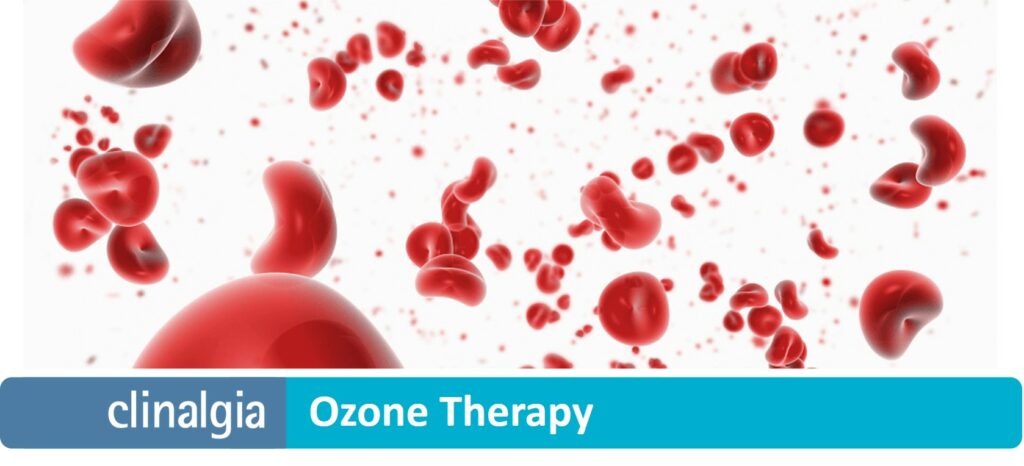
Ozone Therapy: What it is, What it’s for, Benefits and much more
Ozone Therapy Index:
-
- What is ozone therapy?
- What it is used for
- How it works
- What illnesses it cures
- How it is applied
- Ozone therapy forums
- Ozone therapy and disc herniation
- Benefits of ozone therapy
- Contraindications of ozone therapy
- Training in Ozone Therapy
1. What is ozone therapy
Ozone therapy is the use of medical ozone as a biological medicine, suitable and safe to be applied in the treatment of chronic pain and numerous diseases, all of them related to cell damage due to excess of free radicals (oxidative stress).
Given the growing interest in this technique, in 2015 the World Federation of Ozone Therapy (WFOT) published a scientific text aimed at all health professionals interested in the pharmacology, biochemistry and uses of medical ozone.
This text is available in several languages on the website of the Spanish Society of Ozone Therapy (SEOT).
Medical ozone is a mixture of low concentrations of ozone with medical oxygen.
According to the text, it must be produced with a generator that is non-toxic, reliable and allows accurate measurements.
2. What it is used for
Mainly for the treatment of pain and chronic inflammation.
In addition, it can be very useful in the treatment of patients suffering from processes related to the alteration of the cellular oxidation-reduction balance, i.e. with an excess of free radicals.
These include, in particular, chronic inflammation of any kind, immune processes, ischaemic processes and infectious processes.
3. How it works
Basically, medical ozone has a «vaccine effect» on the organism, as it stimulates antioxidant defences by provoking a small controlled oxidation (cellular oxidative pre-conditioning).
This stimulation is risk-free, as modern generators are incapable of generating minimally toxic doses.
It has been shown that oxidative preconditioning triggers molecules in our cells that activate genes for cellular repair and defence, such as antioxidants, anti-inflammatory, anti-tumour and reoxygenating genes.
4. What diseases it cures
Ozone therapy is a complementary treatment for many chronic diseases which, unfortunately, cannot be cured.
Given its excellent tolerability and minimal risk, it is ideal for improving the quality of life in patients with chronic pain (maximum level of scientific evidence) and in infectious, ischaemic and autoimmune processes.
All safety studies (tolerability, teratogenicity and carcinogenicity) have been carried out in accordance with the regulations of the US Food and Drug Administration (FDA), the World Health Organisation (WHO) and the Cuban Regulatory Agency, one of the most prestigious in the world.
In preclinical studies, more than 60 publications endorse its harmlessness and efficacy as a protector in models of kidney, liver, brain, heart, pancreatic, intestinal, bone and muscle damage.
Different research groups have published clinical studies showing it to be useful and very well tolerated in cardiovascular and cerebrovascular, neurological, ophthalmological, pneumological, digestive, metabolic, rheumatological, odontological, etc. diseases.
It is worth highlighting the publication of a series of studies that demonstrate its interest as an adjuvant to cancer patient treatments, both as a protector against the damage caused by chemotherapy and radiotherapy, as well as for improving immunity and favouring the healing of complicated wounds.
5. How it is applied
It can be administered by any route, depending on the indication, except for inhalation: breathing ozone is strictly forbidden.
It is generally infiltrated in pain medicine, helping to regenerate and reduce inflammation in muscles, tendons, ligaments, intervertebral discs and joints.
Topically it is used to promote wound healing processes.
By systemic application (rectal enemas or indirect intravenous administration), it is used for the complementary treatment of numerous diseases and has a great future in preventive medicine.
6. Ozone therapy forums
For scientific information you can consult the pages of the Spanish Society of Ozone Therapy (SEOT) or the World Federation of Ozone Therapy (WFOT).
From these portals you can download the referenced document, with more than 300 bibliographic references.
In addition, searching in Pub Med (National Institute of Health and National Library of the USA) you can find more than 3,000 scientific papers.
7. Ozone therapy and disc herniation
Chronic non-specific low back pain is often one of the main consultations in pain medicine. Once surgery has been ruled out, the approach should be as conservative as possible.
Treatment of herniated discs with ozone therapy is becoming increasingly widespread and there is scientific evidence of long-term superiority in low back pain compared to other types of treatment.
Medical ozone protocols provide safe and therefore repeatable treatments that have been shown to improve the quality of life of patients.
In lumbar pathology, the number of studies is extensive.
The positive results, together with the safety of the technique and the feared complications of surgery, mean that more and more authors consider conservative treatments with ozone therapy, whether paravertebral or intradiscal, to be the first choice.
Cochrane is a fully independent international reference body, whose work for more than 25 years has consisted of improving health knowledge and medical decision-making on treatments based on scientific evidence.
In 2013, with regard to ozone therapy as a treatment for low back pain, and after an exhaustive systematic review, the Cochrane concludes that «there is evidence of long-term superiority of ozone therapy for the treatment of chronic lumbosciatica compared with steroid injection, radiofrequency and open surgery».
8. Benefits of ozone therapy
At present, we have scientific support for the benefits of ozone therapy, both at preclinical and clinical level, amply supported by publications in prestigious journals.
The benefits of ozone therapy properly applied without risk is a sufficiently proven medical reality that can be used to improve the quality of life in critical illnesses, always complementing classical medicine.
9. Contraindications
The contraindications of ozone therapy are minimal and the prevention of pain is its best antidote.
All authors agree on the safety of ozone therapy treatments, especially now that modern, high-precision machines are available.
Relative contraindications for systemic ozone therapy include uncontrolled hyperthyroidism, thrombocytopenia, severe cardiovascular instability and convulsive states.
It is also not advisable, as a matter of medical prudence, to apply systemic ozone therapy to pregnant patients.
Of course, ozone therapy must be carried out by a medical expert, and a diagnosis of the patient’s pro-oxidant-antioxidant state would be desirable.
10. Training in ozone therapy
Despite the fact that the Ministry of Health recently did not include ozone therapy as a pseudoscience in 2019, few universities have included some kind of postgraduate course in ozone therapy as the University of Seville or the University Juan Carlos I did in their day, although they are not in force today.
The University of Valencia in its own Master’s Degree in Research and Treatment specialising in Pain includes a small section on ozone therapy treatment.
On the other hand, among the most innovative initiatives in teaching and research is the UCAM Chair of Ozone Therapy and Chronic Pain in collaboration with Dr. Francisco Javier Hidalgo Tallón, Medical Director of Clinalgia.
In this sense, Dr. Hidalgo Tallón is promoting courses, conferences and seminars to disseminate the benefits of ozone therapy.
At Clinalgia, we have a team of specialists in ozone therapy to combat chronic pain led by Dr. Hidalgo Tallón.
You can contact us without any obligation.



